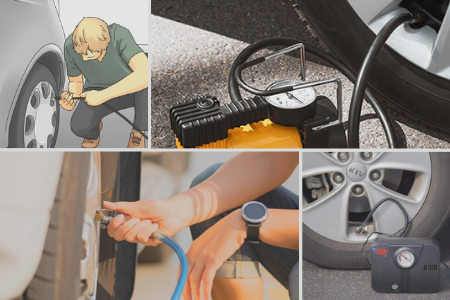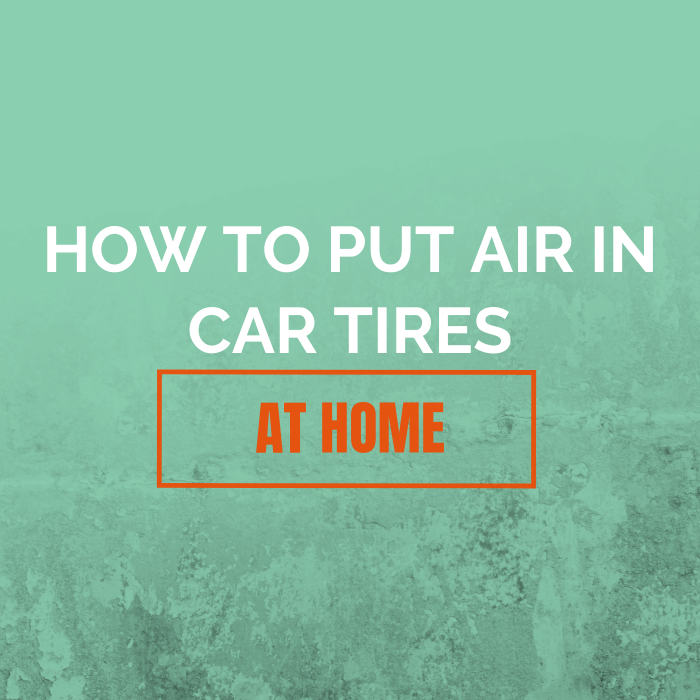So, you have decided to inflate your car tires at home from now on rather than going to a gas station. But you are confused about how to do so. Right? Don’t worry. I will tell you how to inflate car tires at a house garage and what basic tools you need for that.
I do appreciate your decision because you are not only going to master a skill, but improve safety for both you and your car and maximize the gas mileage as well.
Besides, the filling tire at the service station is no longer free. It charges a few cents that you often forget to bring with for air dispenser.
However, inflating car tires at home garage is not difficult at all and takes a few minutes only. Let’s start inflating.
Tools you need for putting air in tires are:
- 1Tire pressure gauge
- 2Tire inflator
- 3User manual
8 Genius Hacks You Should Follow to Inflate The Car Tires

Pick Up a Pressure Gauge
The most important tool you need for tire inflation is the tire pressure gauge that will you find in any auto parts store. The most used types are pencil, dial, and digital. You can choose any of them, but experts suggest going with digital one as they can provide accurate readouts of current pressure.
Know the Recommended PSI by the Manufacturer
It’s essential to know the standard tire pressure specified by the manufacturer. And you can find this in the user manual given by the manufacturer.
If you have lost the owner’s manual, you are supposed to get the recommended pressure in the diver side door jamb on a sticker. Be noted that the PSI mentioned in the tire sidewall is not the recommended pressure but the maximum.
Buy a Tire Inflator
As tire inflation doesn’t require higher PSI, you would better buy a tire inflator instead of an air compressor. Of course, the tire inflators are a kind of small air compressor, but they are specially designed for tire inflation.
The tire inflators are handier and more versatile tools. They are cheaper than air compressor and can operate at the standard household outlet. Some come with different accessories and needles so that you can inflate the tubeless bike, bicycle tire and basketball at home. Choose the best one that can meet your needs.
Check the Tire Pressure with the Gauge
Before inflating the tire, you must check the current pressure with the tire gauge when the tire is cold. To do this, remove the stem valve cap and keep it in a safe place so that you don’t lose it.
Then press the open end of the gauge down onto the valve stem and hold it firmly until you get a hissing sound since a little amount of air releases. Now read the readings shown in the tire inflator gauge.
Determine How Much Pressure You Need to Add
You must determine how much the tire should be inflated to by comparing the recommended PSI set by the manufacturer with the pressure you found in the gauge while checking. You can take a piece of paper and pen to calculate the required PSI.
Deducting the current pressure readout provided by the gauge from the Standard PSI will give you the amount of pressure you need to add to the tire.
Adjust the Tire Pressure
Turn the inflator on and place the hose nozzle onto the valve stem. Then press the lever down as you did with the gauge to check the pressure. When the air starts flowing through hose and going into the tire, you will feel and hear a hissing sound. Press more tightly if the air goes around the valve. Check out tire pressure gauge for racing.
Check the Pressure After Each Time
As you go until you reach the recommended pressure, you need to check the pressure with your gauge on an interval. Release the inflation lever and check the pressure. If still low pressure, continue inflating and checking until the desired PSI is obtained.
If the tire is over inflated, press the center pin of the stem valve down to release the air from the tire.
Replace the Stem Valve
Replace the cap after the tire is properly inflated. Repeat this process for each of the tire.
More Tips and Tricks You Can Read:
Oil vs Oil Free Air Compressor Guide
Tips to Calculate CFM of The Air Compressor
Checking The Tire Pressure at a Gas Station
How to Put Air in Tires Without a Gauge
How to Increase CFM on An Air Compressor? Is It Possible?
How to Quiet an Air Compressor? 7 Noise Reduction Techniques

Olivia Archer provides in-depth coverage of air compressors, air compressor accessories, tire inflators and all things related to air compressors. She is a mechanical engineer and air compressor expert with a wealth of knowledge and experience in the industry.
Olivia’s articles are informative, well-researched and provide readers with valuable insights and information to help them make informed decisions when purchasing air compressors and accessories. She is passionate about the industry and is always looking for new ways to share her knowledge and expertise with readers. When she’s not writing for the website, Olivia can be found working on her own DIY projects, experimenting with different tools and techniques, and expanding her knowledge of the industry.


